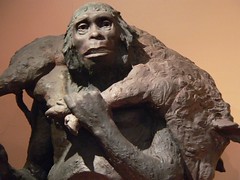 | |
| Elisabeth Daynès at her studio in Paris working at the coloration of Paranthropus boisei male (2.5 million years B.P. discovered in Tanzania) made on the cast of the skull OH5 © 2006 Photographe P.Plailly Image courtesy of The French Technology Press. |
This year's 3-D art prize, awarded on October 13, 2010, was presented to paleoartist Elisabeth Daynès.
With hundreds of anthropological sculptures, Elisabeth Daynès has become a leading expert in the extremely painstaking process of hominid reconstructions. A painter, a sculptor and an expert in comparative anatomy altogether, she combines scientific research, technological innovation and art, in order to bring our human ancestors back to life.
Neanderthal male - 60 000 years B.P. – made on the basis of the cast of the
skull discovered in the cave of Shanidar – Iraq © 2009 Photo S. Plailly . Image
courtesy of French Technology Press.
Daynès strives to create a unique and specific early human or pre-human using the scarce information left by the remains of fossils that might be thousands or even a million years old. “Lucy the Australopithecus" and "Flores the hobbit" she created with Prof. Bill Jungers, often described as her finest works, are part of the hundreds of her anthropological sculptures scattered around the world in leading museums along with Toumaï, Australopithecus, Paranthropus, Homo habilis, Homo erectus, Neanderthals, Homo sapiens, etc. - French Technology Press Office
 Image by mharrsch via Flickr As I look at her reconstruction of Neanderthal, I am amazed at how much the science of reconstruction has progressed since a model of Neanderthal was prepared for the Panama-California Exposition in 1915 (image left). I photographed the 1915 model on a visit to the Museum of Man in San Diego in March 2006.
Image by mharrsch via Flickr As I look at her reconstruction of Neanderthal, I am amazed at how much the science of reconstruction has progressed since a model of Neanderthal was prepared for the Panama-California Exposition in 1915 (image left). I photographed the 1915 model on a visit to the Museum of Man in San Diego in March 2006.I think Daynès reconstruction or one very much like it must have been used in an exhibit on early man I saw at the Oregon Museum of Science and Industry some years ago. One display had a Neanderthal dressed in modern clothes and, as the signboard pointed out, if we passed a Neanderthal on the street we probably wouldn't even pay him much notice. He definitely did not look like the Geico caveman!
I see Daynès was also involved with the reconstruction of the bust of Tutankhamen for the “The New Face of King Tut” exhibition about six years ago. Although some people commented that Tut was not particularly handsome, I thought he looked very interesting.
Using CT data from scans of Tut, a French team worked with National Geographic magazine to create a model of Tut's skull, which then was turned into an accurate, likelife face by one of the world's leading anthropological sculptors, Elisabeth Daynes of Paris. Her flesh-toned silicone cast was embellished with realistic glass eyes, hair, eyelashes and even the eye makeup that adorned the king as he was in life. French, American and Egyptian teams, under the director of Zahi Hawass of Egypt's Supreme Council of Antiquities, each created a separate reconstruction of Tut's face. (Credit: Supreme Council of Antiquities, Egypt and National Geographic Magazine, June 2005) - The Fresh Face of King Tut, Science Daily






Fascinating post M! The process used in such reconstructions is an interesting blend of art and science.
ReplyDeleteKind Regards
H Niyazi
threepipeproblem.blogspot.com